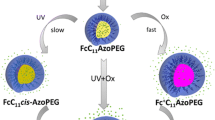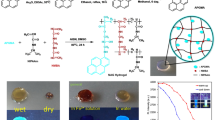Abstract
Photoresponsive hydrogels have been attractive because they can provide precise spatial and temporal control for molecule release, whereas the conventional preparation of photoresponsive hydrogels generally involves complex chemical synthesis steps or specific conditions which limits their practical applications. Herein, a new photoresponsive hydrogel is facilely prepared via co-assembly of two simple molecules, Fmoc-Phe-OH and Azp, without chemical synthesis. The co-assembly mechanism, morphology, and photoresponsiveness of (Fmoc-Phe-OH)-Azp hydrogel are investigated by circular dichroism (CD), ultraviolet-visible (UV-Vis), fluorescence, 1H nuclear magnetic resonance (1H-NMR), attenuated total internal reflection Fourier transform Infrared (ATR-FTIR) spectroscopy, and scanning electron microscopy (SEM). Furthermore, the enhanced release of encapsulated sulforhodamine B (SRB) dye molecules can be achieved via UV light irradiation. The enhanced dye release amount can be controlled by manipulating photoirradiation time. This study provides a facile way to prepare photoresponsive hydrogel which holds great potential for controllable drug release.
Similar content being viewed by others
References
Dou, X. Q.; Feng, C. L. Amino acids and peptide-based supramolecular hydrogels for three-dimensional cell culture. Adv. Mater. 2017, 29, 1604062.
Du, X. W.; Zhou, J.; Shi, J. F.; Xu, B. Supramolecular hydro-gelators and hydrogels: From soft matter to molecular biomaterials. Chem. Rev. 2015, 115, 13165.
Wang, Y. C.; Shim, M. S.; Levinson, N. S.; Sung, H. W.; Xia, Y. N. Stimuli-responsive materials for controlled release of theranostic agents. Adv. Funct. Mater. 2014, 24, 4206.
Zhang, W. M.; Zhang, J.; Qiao, Z.; Yin, J. Functionally oriented tumor microenvironment responsive polymeric nanoassembly: Engineering and applications. Chinese J. Polym. Sci. 2018, 36, 273.
Samai, S.; Sapsanis, C.; Patil, S. P.; Ezzeddine, A.; Moosa, B. A.; Omran, H.; Emwas, A. H.; Salama, K. N.; Khashab, N. M. A light responsive two-component supramolecular hydrogel: A sensitive platform for the fabrication of humidity sensors. Soft Matter 2016, 12, 2842.
He, M. T.; Li, J. B.; Tan, S.; Wang, R. Z.; Zhang, Y. Photodegradable supramolecular hydrogels with fluorescence turn-on reporter for photomodulation of cellular microenvironments. J. Am. Chem. Soc. 2013, 135, 18718.
Chen, Q.; Lv, Y. X.; Zhang, D. Q.; Zhang, G. X.; Liu, C. Y.; Zhu, D. B. Cysteine and pH-responsive hydrogel based on a saccharide derivative with an aldehyde group. Langmuir 2010, 26, 3165.
Sarkar, K.; Dastidar, P. Supramolecular hydrogel derived from a C3-symmetric boronic acid derivative for stimuli-responsive release of insulin and doxorubicin. Langmuir 2018, 34, 685.
Wang, F.; Feng, C. L. Metal-ion-mediated supramolecular chirality of L-phenylalanine based hydrogels. Angew. Chem. Int. Ed. 2018, 57, 5655.
Cheng, C.; Tang, M. C.; Wu, C. S.; Simon, T.; Ko, F. H. New synthesis route of hydrogel through a bioinspired supramolecular approach: Gelatin, binding interaction, and in vitro dressing. ACS Appl. Mater. Interfaces 2015, 7, 19306.
Kuddushi, M.; Patel, N. K.; Rajputt, S.; Shah, A.; EI Seoud, O. A.; Malek, N. I. Thermo-switchable de novo ionic liquid-based gelators with dye absorbing and drug encapsulating characteristics. ACS Omega 2018, 3, 12068.
Shankar, B. V.; Patnaik, A. A new pH and thermo-responsive chiral hydrogel for stimulated release. J. Phys. Chem. B 2007, 111, 9294.
Lu, X. J.; Yang, X. Y.; Meng, Y.; Li, S. Z. Temperature and pH dually-responsive poly(ß-amino ester) nanoparticles for drug delivery. Chinese J. Poly. Sci. 2017, 35, 534.
Ji, W.; Liu, G. F.; Xu, M. X.; Feng, C. L. A redox-responsive supramolecular hydrogel for controllable dye release. Macromol. Chem. Phys. 2015, 216, 1945.
Wojciechowski, J. P.; Martin, A. D.; Thordarson, P. Kinetically controlled lifetimes in redox-responsive transient supramolecular hydrogels. J. Am. Chem. Soc. 2018, 140, 2869.
Yao, L.; Krause, S. Electromechanical responses of strong acid polymer gels in DC electric fields. Macromolecules 2003, 36, 2055.
Ji, W.; Liu, G. F.; Wang, F.; Zhu, Z.; Feng, C. L. Galactosedecorated light-responsive hydrogelator precursors for selectively killing cancer cells. Chem. Commun. 2016, 52, 12574.
Ji, W.; Qin, M. G.; Feng, C. L. Photoresponsive coumarinbased supramolecular hydrogel for controllable dye release. Macromol. Chem. Phys. 2018, 219, 1700398.
Roth-Konforti, M. E.; Comune, M.; Halperin-Sternfeld, M.; Grigoriants, I.; Shabat, D.; Adler-Abramovich, L. UV light-responsive peptide-based supramolecular hydrogel for controlled drug delivery. Macromol. Rapid Commun. 2018, 1800588.
Yang, Q. F.; Wang, P.; Zhao, C. Z.; Wang, W. Q.; Yang, J. F.; Liu, Q. Light-switchable self-healing hydrogel based on hostguest macro-crosslinking. Macromol. Rapid Commun. 2017, 38, 1600741.
Liu, G. F.; Ji, W.; Wang, W. L.; Feng, C. L. Azobenzene derivatives as 3D scaffolds for photoguiding cell adhesion and release. ACS Appl. Mater. Interfaces 2015, 7, 301.
Wang, W.; Gao, F.; Yao, Y.; Lin, S. L. Directional photo-manipulation of self-assembly patterned microstructures. Chinese J. Polym. Sci. 2018, 36, 297.
Muraoka, T.; Koh, C. Y.; Cui, H. G.; Stupp, S. I. Lighttriggered bioactivity in three dimensions. Angew. Chem. Int. Ed. 2009, 48, 5946.
Komatsu, H.; Tsukiji, S.; Ikeda, M.; Hamachi, I. Stiff, multistimuli-responsive supramolecular hydrogels as unique molds for 2D/3D microarchitectures of live cells. Chem. Asian J. 2001, 6, 2368.
Yang, R. M.; Peng, S. H.; Wan, W. B.; Hughes, T. C. Azobenzene based multistimuli responsive supramolecular hydrogels. J. Mater. Chem. C 2014, 2, 9122.
Wang, D. S.; Wagner, M.; Butt, H. J.; Wu, S. Supramolecular hydrogels constructed by red-light-responsive host-guest interactions for photo-controlled protein release in deep tissue. Soft Matter 2015, 11, 7656.
Dou, X. Q.; Li, P.; Zhang, D.; Feng, C. L. C2-symmetric benzene-based hydrogels with unique layered structures for controllable organic dye adsorption. Soft Matter 2012, 8, 3231.
Dou, X. Q.; Zhang, D.; Feng, C. L.; Jiang, L. Bioinspired hierarchical surface structures with tunable wettability for regulating bacteria adhesion. ACS Nano 2015, 9, 10664.
Liu, J. Y.; Yuan, F.; Ma, X. Y.; Auphedeous, D. Y.; Zhao, C. L.; Liu, C. T.; Shen, C. Y.; Feng, C. L. The cooperative effect of both molecular and supramolecular chirality on cell adhesion. Angew. Chem. Ind. Ed. 2018, 57, 6475.
Liu, G. F.; Zhang, D.; Feng, C. L. Control of three-dimensional cell adhesion by the chirality of nanofibers in hydrogels. Angew. Chem. Int. Ed. 2014, 53, 7789.
Huang, S.; Chen, Y. X.; Ma, S. D.; Yu, H. F. Hierarchical selfassembly in liquid-crystalline block copolymers enabled by chirality transfer. Angew. Chem. Int. Ed. 2018, 57, 12524.
Ryan, D. M.; Doran, T. M.; Anderson, S. B.; Nilsson, B. L. Effect of C-terminal modification on the self-assembly and hydrogelation of fluorinated Fmoc-Phe derivatives. Langmuir 2011, 27, 4029.
Zhang, P.; Huang, Y. X.; Kwon, Y. T.; Li, S. PEGylated Fmocamino acid conjugates as effective nanocarriers for improved drug delivery. Mol. Pharmaceutics 2015, 12, 1680.
Dou, X. Q.; Li, P.; Lu, S. Q.; Tian, X. B.; Tang, Y. T.; Mercer-Chalmers, J. D.; Feng, C. L.; Zhang, D. Highly directional coassembly of 2,6-pyridinedicarboxylic acid and 4-hydroxypyridine based on low molecular weight gelators. J. Mol. Liq. 2013, 180, 129.
Zhang, H. B.; Zhao, R.; Jackson, J. K.; Chiao, M.; Yu, H. F. Janus ultrathin film form multi-level self-assembly at air-water interfaces. Chem. Commun. 2014, 50, 14843.
Liu, H.; Kobayashi, T.; Yu, H. F. Easy fabrication and morphology control of supramolecular liquid-crystalline polymer microparticles. Macromol. Rapid Commun. 2011, 32, 378.
Yu, H. F.; Liu, H.; Kobayashi, T. Fabrication and photoresponse of supramolecualr liquid-crystalline microparticles. ACS Appl. Mater. Interfaces 2011, 3, 1333.
Chakraborty, P.; Mondal, S.; Khara, S.; Bairi, P.; Nandi, A. K. Integration of poly(ethylene glycol) in N-fluorenylmethoxycarbonyl-L-tryptophan hydrogel influencing mechanical, thixotropic, and release properties. J. Phys. Chem. B 2015, 119, 5933.
Liu, G. F.; Sheng, J. H.; Teo, W. L.; Yang, G. B.; Wu, H. W.; Li, Y. X.; Zhao, Y. L. Control on dimensions and supramolecular chirality of self-assemblies through light and metal ions. J. Am. Chem. Soc. 2018, 140, 16275.
Galanti, A.; Diez-Cabanes, V.; Santoro J.; Valášek, M.; Minoia, A.; Mayor, M.; Cornil, J.; Samorì, P. Electronic decoupling in C3-symmetrical light-responsive tris(azobenzene) scaffolds: Self-assembly and multiphotochromism. J. Am. Chem. Soc. 2018, 140, 16062.
Acknowledgments
This work was financially supported by the Alexander von Humboldt Foundation (postdoc stipend to X. Q. Dou), the European Research Council (No. 279202), and the National Natural Science Foundation of China (Nos. 51833006 and 51573092). We thank Dipl.-Ing. Gregor Schulte for his technical support, as well as Prof. Dr. Ulrich Jonas, Dipl.-Labchem. Petra Frank (Macromolecular Chemistry, Department Chemistry–Biology, University of Siegen), who kindly granted access to ATR-FTIR measurement, and Prof. Dr. Heiko Ihmels (Organic Chemistry II, University of Siegen) who kindly provided access to the CD measurement.
Author information
Authors and Affiliations
Corresponding authors
Electronic supplementary material
Rights and permissions
About this article
Cite this article
Dou, XQ., Zhao, CL., Mehwish, N. et al. Photoresponsive Supramolecular Hydrogel Co-assembled from Fmoc-Phe-OH and 4,4′-Azopyridine for Controllable Dye Release. Chin J Polym Sci 37, 437–443 (2019). https://doi.org/10.1007/s10118-019-2223-2
Received:
Accepted:
Published:
Issue Date:
DOI: https://doi.org/10.1007/s10118-019-2223-2




